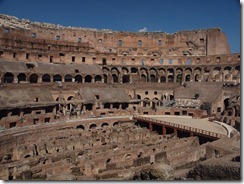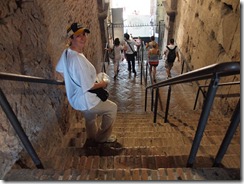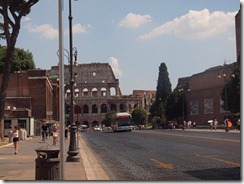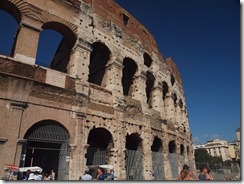[Continued from Part 2]
Once in our room, we freshened up and then headed out to explore Rome. Our first stop? The Coliseum, naturally. We had multi-site passes to redeem which gave us "Walk in" access, bypassing the very large waiting queue.
the Coliseum is something you can see from a long way off: a bit like Mont of Michel. Seeing it up close and personal is another story. Call it an amazing reality check, but here is something unlike anything else. 
So we approached this amazing monument in awe.
Walking down Via Fort Imperiali, past ruins of associated buildings (Domii, Marketplacii and/or Templii) our attention is drawn to two additional things:
1. the Arch of Constantine and
2. they let thousands of cars per day drive right by this (it’s in the center of a major traffic hub)??
As we get closer, we were a little taken aback by the mix of Australians and Canadians ringing the Coliseum hocking tours of the said attraction. Nevertheless, in we walked.
We redeemed our ‘Rome Archaeological Pass’ and bypassed the long queue, strolling inside this centuries old stadium.
 It was hard not to reflect on how ingenious the Romans were with their architecture, for something of this size and magnitude to have stood for so long, given the multiple times Rome was sacked after the collapse of the Roman Empire.
It was hard not to reflect on how ingenious the Romans were with their architecture, for something of this size and magnitude to have stood for so long, given the multiple times Rome was sacked after the collapse of the Roman Empire.
Of course today the Coliseum is but a shell of its former glory. stripped bare to the stone infrastructure, most of it has been removed and ‘recycled’ into other buildings (a common practice over the years).
Another consideration: given its pagan roots, It is a wonder It survived the ascendancy of Christianity, unlike many pagan temples of the era.
Anyhow, back to the present day. The building sure has seen better times, but standing amongst so much history – not to mention a national icon -was a very moving experience.
 The Coliseum is built in layers or tiers. Less than half of the outermost (and tallest) layer remains.
The Coliseum is built in layers or tiers. Less than half of the outermost (and tallest) layer remains.
The third layer is visibly bare where It would have connected to the outer ring. Inside, all the internal infrastructure is gone. As mentioned previously, likely to have been stripped off and used elsewhere.
Statues and precious metals, which one might presume had adorned the structure, are also gone- it is a skeleton. Despite the lack of furnishing, the Coliseum is still impressive. It is a feat of engineering perhaps unrivalled for its time.
The remains of the outer layer are used for ticket sales & queues (lowest level) and as a gallery & bookstore (upper level). We were unable to go to the sub level(s) or above the second level.
The arena floor is bare, displaying the support structures (now in ruins).
It is still possible to imagine a time when the Roman spectators came to watch the Gladiators square off, around 2,000 years ago!
Continued.


unreal guys. The photos are unbelieveable.
Cheers
John